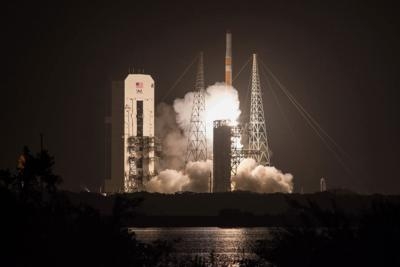Twin GSSAP Satellites Enhance Space Based Situational Awareness
A United Launch Alliance (ULA) Delta IV rocket carrying the AFSPC-6 mission for the United States Air Force lifted off from Space Launch Complex-37 Aug. 19 at 0052 EDT. This is ULA's seventh launch in 2016 and the 110th successful launch since the company was formed in December 2006.

"Thank you to the ULA, Air Force and industry partners for the outstanding teamwork and flawless execution that made today's mission a success," said Laura Maginnis, ULA vice president of Custom Services. "This morning's AFSPC-6 launch is a prime example of why our customers continue to place their trust us to launch our nation's crucial space capabilities."
This mission was launched aboard a Delta IV Medium+ (4,2) configuration Evolved Expendable Launch Vehicle (EELV) powered by one common booster core. The common booster core was powered by an RS-68A liquid hydrogen/liquid oxygen engine producing 702,000 pounds of thrust. A single RL10B liquid hydrogen/liquid oxygen engine powered the second stage. The booster and upper stage engines are both built by Aerojet Rocketdyne. ULA constructed the Delta IV Medium+ (4,2) launch vehicle in Decatur, Alabama.
The AFSPC-6 mission consists of twin Geosynchronous Space Situational Awareness Program (GSSAP) spacecraft, built by Orbital ATK. The new satellites will join the first two GSSAP spacecraft launched approximately two years ago aboard a Delta IV launch vehicle. GSSAP is a space-based capability that collects space situational awareness data, allowing for more accurate tracking and characterization of man-made orbiting objects. It has a clear, unobstructed, and distinct vantage point for viewing resident space objects orbiting earth in a near-geosynchronous orbit without the weather or atmosphere disruptions that limit ground-based observations. The data from GSSAP greatly improves our ability to rapidly detect, warn, characterize and attribute disturbances to space systems in the geosynchronous environment.
ULA's next launch is the Atlas V OSIRIS-REx spacecraft for NASA. The launch is scheduled for Sept. 8 from Space Launch Complex-41 at Cape Canaveral Air Force Station, Florida.
The EELV program was established by the U.S. Air Force to provide assured access to space for Department of Defense and other government payloads. The commercially developed EELV program supports the full range of government mission requirements, while delivering on schedule and providing significant cost savings over the heritage launch systems.
With more than a century of combined heritage, United Launch Alliance is the nation's most experienced and reliable launch service provider. ULA has successfully delivered more than 100 satellites to orbit that provide critical capabilities for troops in the field, aid meteorologists in tracking severe weather, enable personal device-based GPS navigation and unlock the mysteries of our solar system.
(Source: United Launch Alliance news release. Image from ULA Facebook page)
 ANN's Daily Aero-Linx (05.02.24)
ANN's Daily Aero-Linx (05.02.24) ANN's Daily Aero-Term (05.02.24): Touchdown Zone Lighting
ANN's Daily Aero-Term (05.02.24): Touchdown Zone Lighting Aero-News: Quote of the Day (05.02.24)
Aero-News: Quote of the Day (05.02.24) ANN FAQ: Contributing To Aero-TV
ANN FAQ: Contributing To Aero-TV NTSB Final Report: Cirrus Design Corp SR20
NTSB Final Report: Cirrus Design Corp SR20



